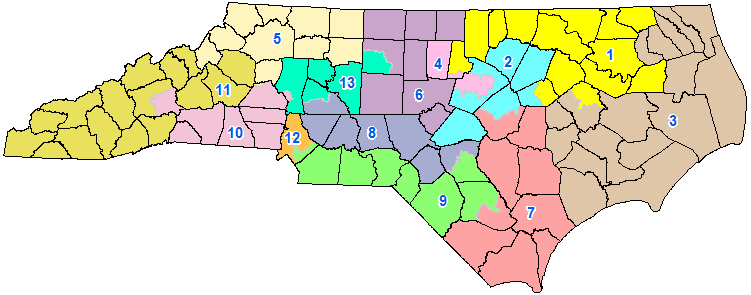NC Congressional Districts Declared Unconstitutional
The results are in: North Carolina’s congressional districts have been accused of gerrymandering for the second time in the past two election cycles. On August 27’th, a three-judge panel ruled that North Carolina’s congressional election districts had been unfairly drawn, giving Republican candidates a significant advantage in elections.
This is not the first time the North Carolina’s districts have been declared by a national court as biased. In 2016, the Supreme Court heard the case of Cooper vs. Harris, ruling 5-3 (Justice Gorsuch took no part in this decision after having been sworn in just a month earlier) that the districts had been racially gerrymandered. When a district or districts are declared racially gerrymandered, it means they have been drawn so that a certain racial minority will be underrepresented, which, unlike some partisan gerrymanders, is unlawful under section two of the Voting Rights Act. The districts were redrawn in 2016 as a reflection of this ruling.
However, in January of 2018 the same three-judge panel that reviewed the maps last August ruled that the re-drawn election districts violated the the First and Fourteenth Amendments. The case was brought to the U.S. District Court for the Middle District of North Carolina by voting-rights advocacy groups such as the League of Women Voters of North Carolina.
When the lines were established in 2016, Republican David Lewis of the North Carolina General Assembly admitted that the districts had been drawn so that the Republicans would win ten seats while Democrats would win three, confirming a partisan gerrymander. Republicans attempted to bring the case to the Supreme Court, but the judges declined. They asked that the case be reviewed so that it could be confirmed that those who challenged the map had a legal standing to do so. The case was once again brought in front of the panel, who determined the plaintiffs (those who bring a case against another in a court of law) had standing to bring the suit.
Gerrymandering has been an issue in America since the 1800’s, democrats and republicans both being equally guilty. Some recent cases include Gill v. Whitford from Wisconsin as well as Benisek v. Lamone from Maryland for partisan gerrymandering. The case of Abbott v. Perez from Texas was also ruled on by the Supreme Court last June for racial gerrymandering, the court finding that one of the districts was an impermissible racial gerrymander.
The North Carolina case will now join these in standing in front of the Supreme Court. While there are typically nine justices, the retirement of Justice Kennedy means there are currently eight. Brett Kavanaugh has been nominated for the open position, and has recently completed his confirmation hearing. If the Senate does not confirm him by the time the case is heard, either one justice will have to swing from their typically conservative or liberal rulings, or the lower court’s decision will be upheld.
It has been determined by the judges that the congressional maps will remain intact before the November election, despite some judges insistence that they be redrawn before the crucial date. The judges declared that by redrawing the maps before election day voters may become confused, leading to a potentially lower turnout.












